Emotet (Virus Removal Guide) - updated May 2020
Emotet Removal Guide
What is Emotet?
Emotet virus is a well-known banking trojan employed by numerous cybercriminal groups
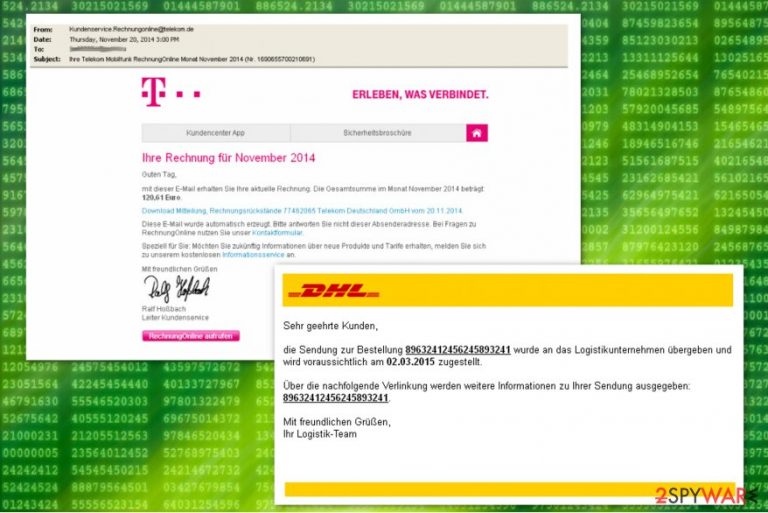
Emotet virus is one of the most prolific modular banking Trojans that first made an appearance back in 2014. Despite its relatively old age, security researchers at Malwarebytes reported [1] that this threat, along with TrickBot , is the most prevalent data-stealing malware in the wild. It is employed by many criminal groups and never stops being distributed around the globe.
Emotet is actively attacking the government, healthcare, education, and manufacturing sectors while spreading via exploits, credential brute-forcing, or a botnet. Previously, the malware used to rely on phishing emails embedded with malicious URLs – these led to a document boobytrapped with macro commands that would install the malicious payload. Nonetheless, attack vectors remain broad, and different criminal gangs take different approach.
Emotet is a data stealer, so its main goal is to copy and send out sensitive information to a remote server, and malware uses a variety of techniques for that. Despite that, it is also equipped with numerous other functions, such as malware delivery and worm-like functionality to spread laterally within the infected company. On top of these destructive traits, the Trojan can also use evasion techniques to avoid detection by some security solutions.
| Summary of the Trojan | |
|---|---|
| Name | Emotet virus / Emotet Trojan |
| Type | Banking trojan, network worm |
| Release date | 2014 |
| Mostly affected countries | Germany, Austria, Switzerland, United States[2] |
| Danger level | High. Spreads via networks and affects all connected computers; steals banking information and might install other malware to the system |
| AV detection | Mal/Emotet-E, Troj/Inject-CRI, Troj/Agent-AWUQ, Troj/Wonton-ABA, Mal/Generic-S, C2/Generic-B, Mal/Emotet-*, HPmal/Emotet-A, HPmal/Emotet-B, Troj/EmotMem-A, Mal/EncPk-ACW |
| Distribution method | Malware is usually delivered via malicious spam email (malspam) attachments, embedded links, or a malicious script. Once present on a network, it can also break into other machines with the help of a brute-forcing technique |
| Elimination | In case the infected computer is connected to a network, you should disconnect it and run a full system scan with reputable anti-malware software such as Malwarebytes |
| System fix | Malware can root itself into the system and affect various vital Windows files. To remediate the computer and avoid reinstalling the OS, we recommend using a PC repair kit FortectIntego |
Emotet virus takes advantage of weak admin passwords and system vulnerabilities that it uses to distribute itself on the computer network. This advanced cyber threat is used for dropping malware on the targeted computers in order to steal financial and banking information.
On the affected machine Emotet Trojan tries to get admin privileges. If it fails to do that, then it runs itself through other system processes. It also makes various changes to the system in order to boot with system startup, collect system information, encrypt it, and send it to its Command & Control server.
Emotet removal is quite complicated due to its specific functionality. The worm is designed to avoid detection. For instance, malware might hide under processes with random or legitimately-looking names, for instance, wingroup.exe or servicelog.exe.
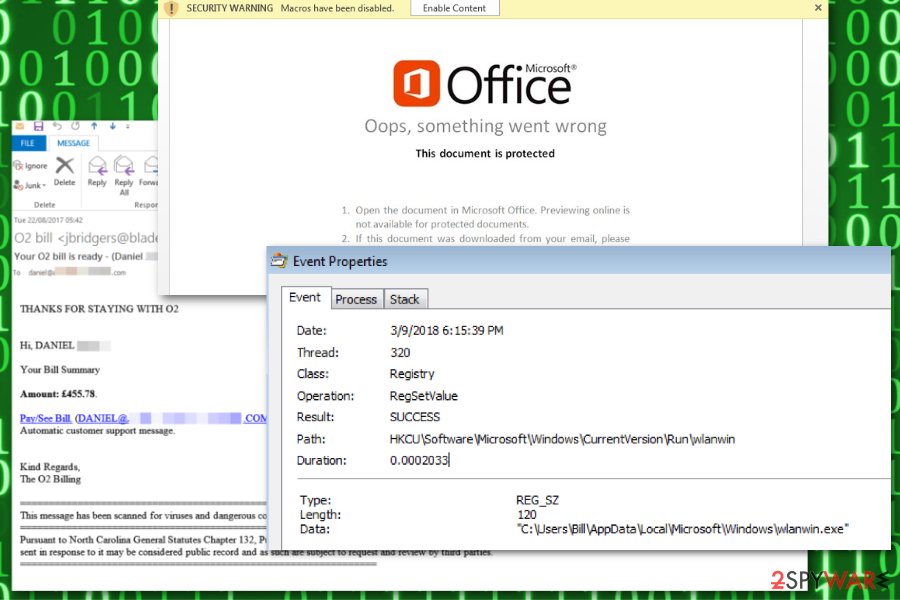
Emotet-related files are usually placed in the following directories:
- C:\Windows\
- C:\windows\system32\
- C:\Windows\Syswow64\
- C:\Users\\AppData\Local\Temp\
However, we do not recommend checking these locations and deleting malicious files manually. It is not an effective way to remove Emotet virus from the device. The worm spreads via the network, so it can re-install itself again.
For this reason, it’s important that all computers connected to the affected network have a powerful antivirus installed. Only powerful malware removal tools can terminate this cyber threat entirely. We highly recommend using well-known anti-virus tools that are known to be capable of eliminating trojan from the system.
It is important to uninstall Emotet immediately because malware is capable of bringing other cyber infections to the system. Security specialists from Viruss.lv[3] report that this banking worm can bring Dridex[4] or Qakbot[5] viruses to the affected systems too.
The most common Emotet variants
| Win32/Emotet Win64/Emotet Mal/Emotet-E Mal/Emotet-* HPmal/Emotet-A HPmal/Emotet-B Troj/EmotMem-A Mal/EncPk-ACW Trojan:Win32/Emotet.PEH!MTB Trojan:Win32/Emotet.CT Trojan:Win32/Emotet.AX Trojan:Win32/Emotet.BE!rfn Trojan:Win32/Emotet.SK!MTB Trojan:Win32/Emotet.AER!MTB Trojan:Win64/Emotet.PDA!MTB Trojan:Win32/Emotet.PED!MTB Trojan:Win32/Emotet.DCV!MTB Trojan:Win32/Emotet.PSM!MTB Trojan:Win32/Emotet.DDM!MTB Trojan:Win32/Emotet.VSB!MTB Trojan:Win32/Emotet.DFJ!MTB Trojan:Win32/Emotet.PEM!MTB Trojan.W97M.EMOTET.UAJS Trojan.W97M.EMOTET.JKAG Trojan.W97M.EMOTET.AFKT Trojan.W97M.EMOTET.TIOIBELH Trojan.W97M.EMOTET.SMBA |
TrojanDropper:JS/Emotet.A TrojanDownloader:Win32/Emotet TrojanDownloader:O97M/Emotet.CSK!MTB TrojanDownloader:O97M/Emotet.TV!MTB TrojanDownloader:O97M/Emotet.ABR!MTB TrojanDownloader:O97M/Emotet.VT!MTB TrojanDownloader:O97M/Emotet.UJ!rfn TrojanDownloader:O97M/Emotet.KAQ!MTB TrojanDownloader:O97M/Emotet.BBZ!MTB TrojanDownloader:O97M/Emotet.LAD!MTB TrojanDownloader:O97M/Emotet.TM!rfn TrojanDownloader:O97M/Emotet.PAF!MTB TrojanDownloader:O97M/Emotet.AAS!MTB TrojanDownloader:O97M/Emotet.FAO!MTB TrojanDownloader:O97M/Emotet.KAB!MTB TrojanDownloader:O97M/Emotet.NAN!MTB TrojanDownloader:O97M/Emotet.IAN!MTB TrojanDownloader:O97M/Emotet.VI!MTB TrojanDownloader:O97M/Emotet.PAM!MTB TrojanDownloader:O97M/Emotet.MAF!MTB TrojanDownloader:O97M/Emotet.JAT!MTB TrojanDownloader:O97M/Emotet.MAM!MTB TrojanDownloader:O97M/Emotet.KAI!MTB TrojanDownloader:O97M/Emotet.IAE!MTB TrojanDownloader:O97M/Emotet.JAI!MTB TrojanDownloader:O97M/Emotet.PAK!MTB TrojanDownloader:O97M/Emotet.CAT!MTB |
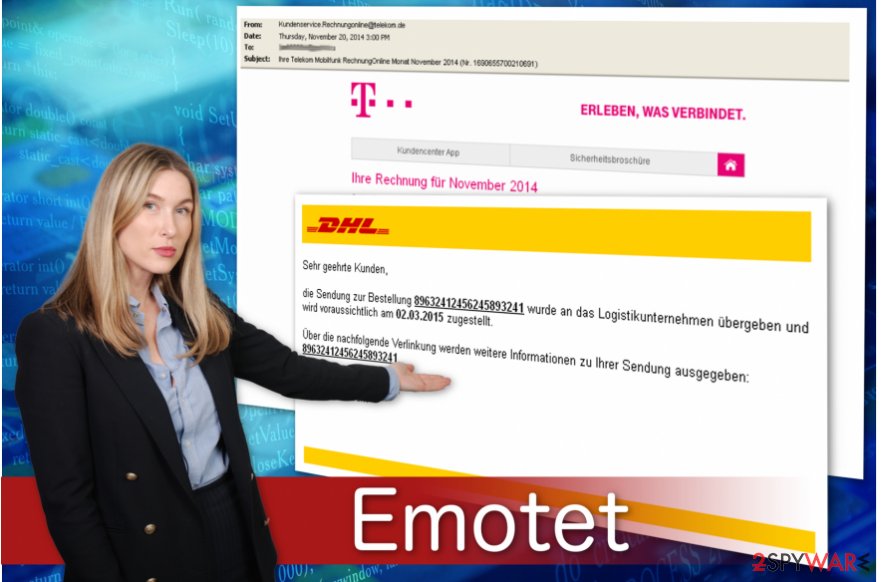
Six years after its creation, Emotet virus is still active – was spotted attacking various organizations throughout 2020
According to the report published by security researchers,[1] the last quarter of 2019 saw a decline in crypto-malware attacks, which totaled 7% year-over-year- increase. Instead, the data-stealing viruses were on the rise and attacked users even more on the end of 2019/ beginning of 2020.
In particular, banking trojan Emotet affected many organizations and firms around the world, but mostly focusing on the US institutions, as it is typical for most malware due to strong economic factors. Emotet and TrickBot were targeting a variety of sectors, including governmental, hospitality, healthcare, manufacturing, and others.
Emotet distribution has been attributed to the TA542 group, which delivers the payload of malware via malicious spam email attachments. The gang took a break for over five months but returned in mid-summer 2020 and delivered booby-trapped emails on an enormous scale (up to one million a day). The contents of emails include both generic themes and trending ones, e.g., COVID-19-related messages are being actively spread, also adapting to local languages.[6]
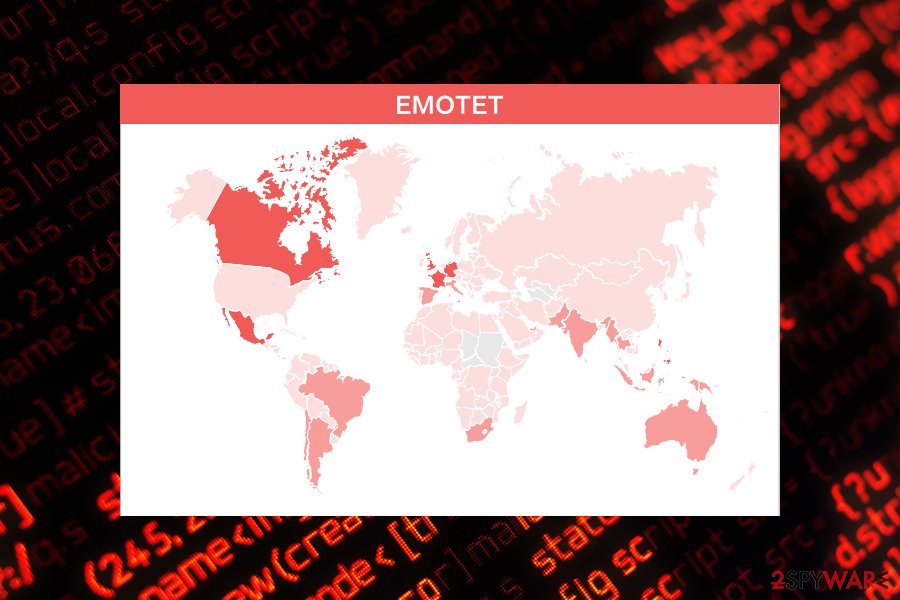
Emotet is also included in a massive botnet. Once the user clicks on the malicious link in the spam email, the malware takes over his or her inbox and can start sending out malspam, and recipients do not suspect that the email is malicious, due to the trusted source.
After that, Emotet exploits EternalBlue to exploit vulnerable systems on the network. The affected computers then spread the virus laterally with the help of brute-forcing. Due to such a complicated scheme, Emotet still manages to rise to the top when it comes to infection rates, and it does not seem that it is stopping any time soon.
Infiltration and operation peculiarities of the Emotet banking Trojan
Authors of this malware have been spreading this malware via malicious spam emails. The phishing email arrives as a spam invoice e-mail or notification to make a payment to lure gullible computer users into opening the malicious link attached to the letter.
The link redirects to the specific URL address which triggers a download of an infected document that includes a malicious macro command. This macro embedded in the document prompts cmd.exe and PowerShell to download malware payload from the malicious website.
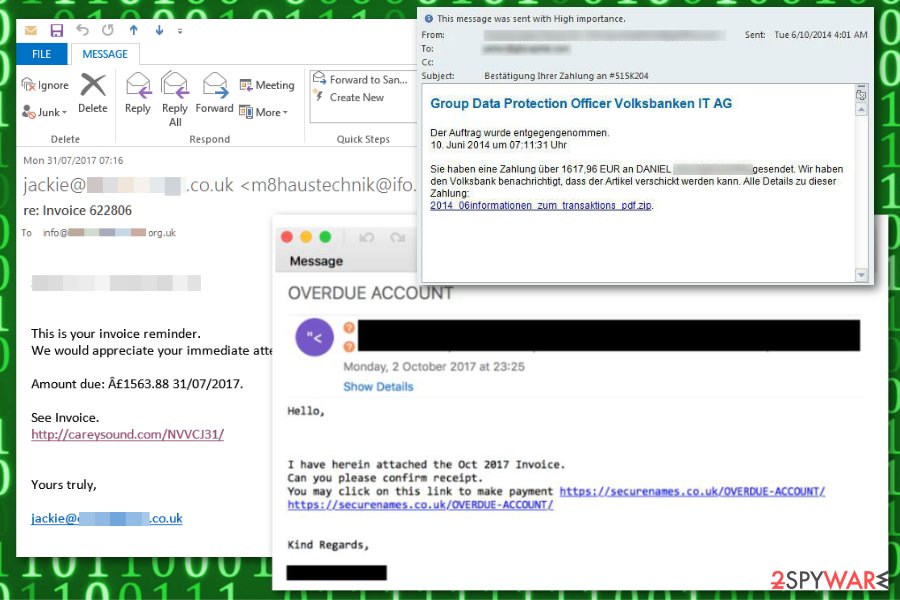
The list of discovered URL links used to distribute Emotet banking trojan:
- hxxp://vanguardatlantic[.]com/Invoice-number-7121315833-issue/;
- hxxp://abbeykurtz[.]com/VZZQNZJIZD9113942;
- hxxp://charly-bass[.]de/Copy-Invoice-0954/;
- hxxp://aplacetogrowtherapy[.]com/CNNKIAPGEP3572621.
After the installation the copies of the malware are stored in the following folders:
- System%\{string 1}{string 2}.exe;
- %AppDataLocal%\Microsoft\Windows\{string 1}{string 2}.exe.
Besides, IT analysts say that the malicious program deletes the Alternate Data Stream (also known as Zone identifier)[7] which determines the source of the file you attempt to download from Internet Explorer. Thus, it is almost impossible to detect trojan by yourself.
Shortly after, the trojan circumvents the system by registering as system service and modifies Windows Registry entries to enable an autostart mechanism. In other terms, Emotet virus sets itself to launch every time you turn on your computer.
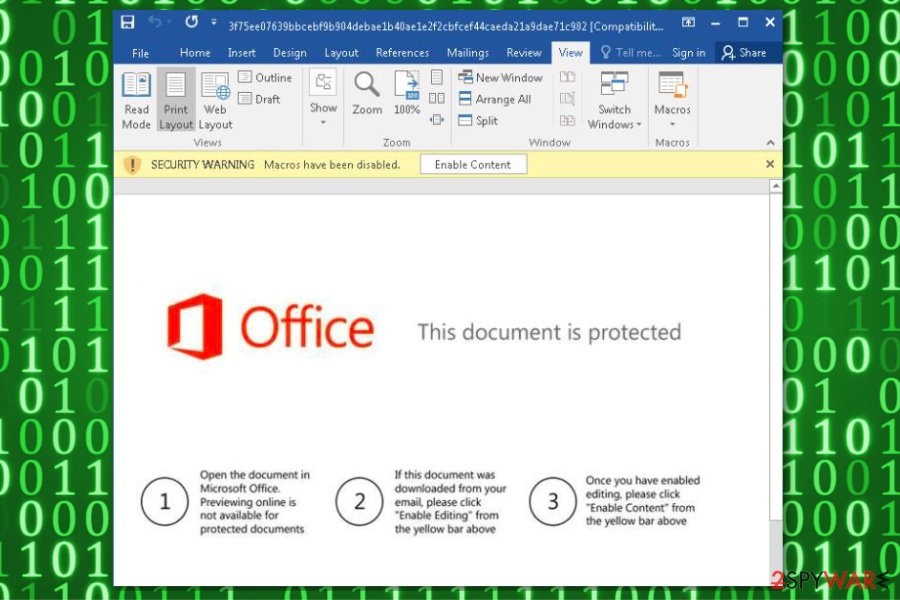
Instructions on how to eliminate Emotet from the affected computer
As mentioned above, this malicious virus can infect other computers connected to the network. If you delay Emotet removal, you risk not only your own safety but other’s as well. Be aware that this is a very dangerous program that is programmed to hide its presence and traces. Trying to get rid of it by yourself might lead to irreversible damage to your system.
We advise you to remove Emotet virus as soon as possible by employing a robust anti-malware program. However, this banking trojan might block the installation of the security software. Thus, you have to reboot your computer to Safe Mode and download it afterward. Shortly after, you will be able to run a full system scan and eliminate the malware.
Keep in mind that you have to remove Emotet from all computers that are connected to the same affected network. If you run a system scan a couple of times and you still find malicious components, it means that some of the machines are still connected. So, trojan removal is a complex task and requires cleaning all connected machines immediately. Finally, fix virus damage with FortectIntego.
Getting rid of Emotet. Follow these steps
Manual removal using Safe Mode
Emotet trojan might be programmed to block the installation of powerful security software. Thus, follow the instructions below to reboot your computer to Safe Mode with networking:
Important! →
Manual removal guide might be too complicated for regular computer users. It requires advanced IT knowledge to be performed correctly (if vital system files are removed or damaged, it might result in full Windows compromise), and it also might take hours to complete. Therefore, we highly advise using the automatic method provided above instead.
Step 1. Access Safe Mode with Networking
Manual malware removal should be best performed in the Safe Mode environment.
Windows 7 / Vista / XP
- Click Start > Shutdown > Restart > OK.
- When your computer becomes active, start pressing F8 button (if that does not work, try F2, F12, Del, etc. – it all depends on your motherboard model) multiple times until you see the Advanced Boot Options window.
- Select Safe Mode with Networking from the list.

Windows 10 / Windows 8
- Right-click on Start button and select Settings.

- Scroll down to pick Update & Security.

- On the left side of the window, pick Recovery.
- Now scroll down to find Advanced Startup section.
- Click Restart now.

- Select Troubleshoot.

- Go to Advanced options.

- Select Startup Settings.

- Press Restart.
- Now press 5 or click 5) Enable Safe Mode with Networking.

Step 2. Shut down suspicious processes
Windows Task Manager is a useful tool that shows all the processes running in the background. If malware is running a process, you need to shut it down:
- Press Ctrl + Shift + Esc on your keyboard to open Windows Task Manager.
- Click on More details.

- Scroll down to Background processes section, and look for anything suspicious.
- Right-click and select Open file location.

- Go back to the process, right-click and pick End Task.

- Delete the contents of the malicious folder.
Step 3. Check program Startup
- Press Ctrl + Shift + Esc on your keyboard to open Windows Task Manager.
- Go to Startup tab.
- Right-click on the suspicious program and pick Disable.

Step 4. Delete virus files
Malware-related files can be found in various places within your computer. Here are instructions that could help you find them:
- Type in Disk Cleanup in Windows search and press Enter.

- Select the drive you want to clean (C: is your main drive by default and is likely to be the one that has malicious files in).
- Scroll through the Files to delete list and select the following:
Temporary Internet Files
Downloads
Recycle Bin
Temporary files - Pick Clean up system files.

- You can also look for other malicious files hidden in the following folders (type these entries in Windows Search and press Enter):
%AppData%
%LocalAppData%
%ProgramData%
%WinDir%
After you are finished, reboot the PC in normal mode.
Remove Emotet using System Restore
If you are still not able to get rid of the banking trojan, try to Command Prompt method. The steps provided below will guide you through the process:
-
Step 1: Reboot your computer to Safe Mode with Command Prompt
Windows 7 / Vista / XP- Click Start → Shutdown → Restart → OK.
- When your computer becomes active, start pressing F8 multiple times until you see the Advanced Boot Options window.
-
Select Command Prompt from the list

Windows 10 / Windows 8- Press the Power button at the Windows login screen. Now press and hold Shift, which is on your keyboard, and click Restart..
- Now select Troubleshoot → Advanced options → Startup Settings and finally press Restart.
-
Once your computer becomes active, select Enable Safe Mode with Command Prompt in Startup Settings window.

-
Step 2: Restore your system files and settings
-
Once the Command Prompt window shows up, enter cd restore and click Enter.

-
Now type rstrui.exe and press Enter again..

-
When a new window shows up, click Next and select your restore point that is prior the infiltration of Emotet. After doing that, click Next.


-
Now click Yes to start system restore.

-
Once the Command Prompt window shows up, enter cd restore and click Enter.
Finally, you should always think about the protection of crypto-ransomwares. In order to protect your computer from Emotet and other ransomwares, use a reputable anti-spyware, such as FortectIntego, SpyHunter 5Combo Cleaner or Malwarebytes
How to prevent from getting trojans
Choose a proper web browser and improve your safety with a VPN tool
Online spying has got momentum in recent years and people are getting more and more interested in how to protect their privacy online. One of the basic means to add a layer of security – choose the most private and secure web browser. Although web browsers can't grant full privacy protection and security, some of them are much better at sandboxing, HTTPS upgrading, active content blocking, tracking blocking, phishing protection, and similar privacy-oriented features. However, if you want true anonymity, we suggest you employ a powerful Private Internet Access VPN – it can encrypt all the traffic that comes and goes out of your computer, preventing tracking completely.
Lost your files? Use data recovery software
While some files located on any computer are replaceable or useless, others can be extremely valuable. Family photos, work documents, school projects – these are types of files that we don't want to lose. Unfortunately, there are many ways how unexpected data loss can occur: power cuts, Blue Screen of Death errors, hardware failures, crypto-malware attack, or even accidental deletion.
To ensure that all the files remain intact, you should prepare regular data backups. You can choose cloud-based or physical copies you could restore from later in case of a disaster. If your backups were lost as well or you never bothered to prepare any, Data Recovery Pro can be your only hope to retrieve your invaluable files.
- ^ 2019 State of Malware. Malwarebytes. Malware report.
- ^ Emotet. Wikipedia. The free encyclopedia.
- ^ Viruss. Viruss. Security and Spyware News.
- ^ Swati Khandelwal. Dridex Banking Trojan Gains ‘AtomBombing’ Code Injection Ability to Evade Detection. The Hacker News. Online cyber security news and analysis.
- ^ Charlie Osborne. Fresh wave of mutating Qakbot malware brings down enterprise networks. ZDNet. Technology news, analysis, comments and product reviews.
- ^ Axel F.. A Comprehensive Look at Emotet’s Summer 2020 Return. Proofpoint. Cybersecurity research blog.
- ^ Zone Identifier ADS’s. Sanderson Forensics. Software Developer.







